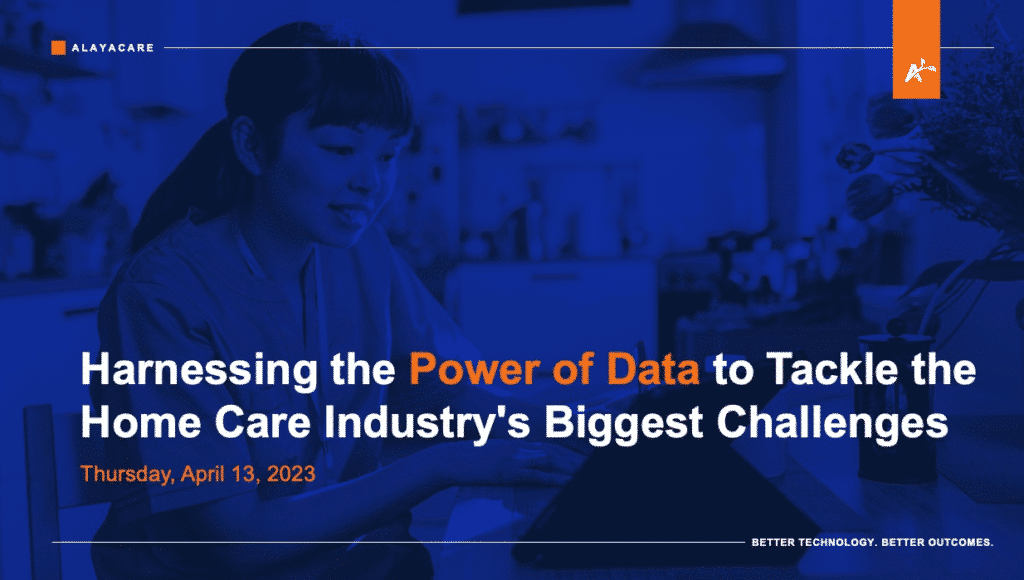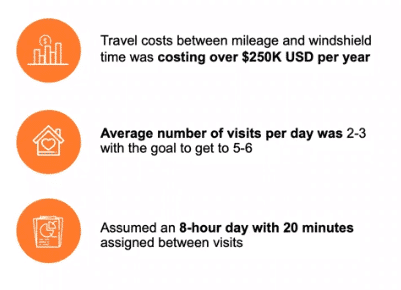Blog
[Webinar recap] Harnessing the Power of Data to Tackle the Home Care Industry’s Biggest Challenges

During our most recent webinar with Home Health Care News (HHCN), we brought together AlayaCare’s data and intelligence team to share their insights on challenges the home care industry faces and how data has the power to help tackle them. In this blog, we highlight the 2 main themes from our webinar Harnessing the Power of Data to Tackle the Home Care Industry’s Biggest Challenges (watch the webinar on-demand here).
Presenters:
Sarah Khalid, Product Manager, Artificial Intelligence/Machine Learning & Optimization, AlayaCare
Naomi Goldapple, SVP, Data and Intelligence, AlayaCare
The home care industry faces many challenges and by utilizing data, organizations can gain a better understanding of the population at home, trends changing over time and any needs or requirements of clients helping to enable more efficient scheduling, better resource allocation, improved client satisfaction levels, streamlined communications and more cost savings. With the ever-increasing amounts of data available today, leveraging these insights is becoming increasingly more important in the home care industry, but when it comes to harnessing data, you need the right tools.
“Harnessing data to understand what our population at home looks like and getting that kind of base information is really important to understand. I get a snapshot of what your population looks like at home, and then if we go further, we can use data to really measure how trends evolve over time. So not just like a static snapshot, but also to see how it changes and how we should respond to this.”
– Naomi Goldapple
In this webinar both Naomi and Sarah dive how leveraging the power of data can provide solutions to these two industry challenges. Here are some highlights from the webinar below…
Employee retention and churn prevention
According to Home Care Pulse’s 2022 benchmarking report, the US home care industry’s average employee turnover rate is 64%, and an AlayaCare employee retention report showed that on average, 1 in 4 employees quit within the first 30 days. With onboarding costing between $2600 USD and $4500 USD per employee, it “is quite costly for agencies at the rate of churn today. So, at the height of the pandemic, our team conducted focus groups to better understand the factors that drive caregivers to quit. We uncovered the top three complaints from exiting workers,” explained Sarah, which were:
- Inconsistent and unpredictable hours (this results in varied pay expectancy from week to week for caregivers)
- Scheduling, management, and a lack of flexibility over caregiver preferences
- Time lag between date of hire and the date of first scheduled visit
“Not feeling valued was also reported and ties in heavily to the overall problem of feeling dissatisfied. So, we became curious about what drives caregiver satisfaction. And that question became a study on the exemplary behaviors and traits of caregivers that have long tenures at these organizations and ultimately love their jobs include inconsistent hours, poor scheduling, and delayed hire dates.”
– Sarah Khalid
To combat this issue, AlayaCare created a robust Retention Dashboard that utilizes data and analytics to better predict employee churn and spot early warning signs. By leveraging these metrics, organizations can build stronger teams that provide long-term healthcare solutions for clients in need. With these tools agencies can build suites of metrics to uncover the answers to the question, who’s at risk of churning?
“So, we’ve built retention metrics that include agency specific predictive scores for each care worker that can be accessed by owners and by HR that are computed on a daily basis. And in addition, baselines across the industry and with competitors with how their workforce is trending could also be monitored over time. Now these insights do uncover early warning signs of churn risk by showing things like who is at a higher degree of late clock ins, the greater travel distance between visits for care workers and high caseloads – just to name a few data points.” Sarah continued to explain that by applying a simple strategy of taking the bottom 10% of what has been identified as dissatisfied employees they saw 22% of high risk of churn employees (symbolized as red) turn green within a month.
Schedule and route optimization
Scheduling and route optimization are crucial components of running an effective home care agency, as one scheduling manager put it during a discovery call with AlayaCare, “we have to beg and talk to staff to arrange their schedule to fit in more clients.” Advanced optimization technologies can help all stakeholders involved: Caregivers want to work flexible shifts without having to travel far between clients; Schedulers want to fulfill a high volume of vacancies now and in the future; Agency leaders want to retain and satisfy their workforce, keep their clients satisfied, and manage costs in order to scale the agency.
“Driving is also the primary mode of travel for caregivers, and travel costs to visits often incur large premium fees for providers to pay out,” said Sarah. “So, reducing the mileage and time traveled wherever possible is a win for everyone. And the environment. Now we’ve piloted decision support tools (Visit Optimizer) to find out that leveraging optimization algorithms does drastically improve the scheduling process overall.”
When agencies allow their field staff to self-schedule, there are opportunities to improve on travel costs and improve on utilization, for example, Sarah explains how “in a pilot we’ve done, you can see the roots of field staff from pre optimization to post. Our results managed to decrease mileage and windshield time by 50% and improve on utilization from 2-3 visits being scheduled per day to 5 to 6.”
Routing challenges pre-optimization:

With the multitude of data that’s collected on a visit level, agencies can really become co-pilots with these technologies and cater these algorithms to their needs and this is all reliant on data.
Home care agencies can learn a lot about AI-driven data and optimization tools to tackle industry challenges like employee retention and churn, and schedule and route processes. By leveraging this technology, home care agencies can ensure that their clients receive the best possible care plan tailored specifically for them.


